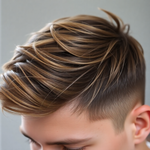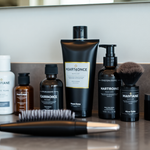
Semi-Permanent Hair Color Calendar: Schedule Hue Changes to Stretch a Sustainable Men's Capsule Wardrobe
19 September 2025
Share
Hook: Get a smarter style refresh without overbuying
Struggling to keep your look fresh without buying new clothes every season? A Semi-Permanent Hair Color Calendar syncs intentional hue changes with your men's capsule wardrobe so you can refresh your vibe, reduce waste, and save money. This guide shows how to plan, apply, and maintain semi-permanent color across a year—practical steps you can start this week.
Semi-Permanent Hair Color Calendar: Why it works for a capsule wardrobe
Pairing your hair color strategy with a curated capsule wardrobe amplifies every outfit. Semi-permanent hair color gives you the flexibility to test tones, create seasonal accents, and avoid the commitment and chemical load of permanent dyes—perfect if sustainability and low maintenance matter.
- Flexibility: Semi-permanent dyes fade gradually, so changes look natural and reversible.
- Fewer resources: Less frequent touch-ups mean fewer products, fewer trips, and less environmental impact.
- Visual cohesion: Intentionally timed color tweaks make staple pieces look new without expanding your closet.
Who this guide is for
- Men aged 18–45 building a compact, wearable wardrobe.
- Anyone prioritizing sustainability, budgeting, and low-effort grooming.
- Guys who want to experiment with color but avoid drastic long-term change.
Core terms and what to expect
- Semi-permanent color: Deposits pigment on the hair surface and cortex without lifting natural pigment—fades over weeks to months.
- Demarcation: Visible line between new growth and dyed hair; planning a calendar reduces jagged transitions.
- Color-safe care: Shampoos and routines that slow fading and protect strand health.
How to choose a cadence: low, balanced, or playful
Match a schedule to your lifestyle and sustainability goals. Below, each cadence includes a typical interval and what to aim for color-wise.
-
Low-maintenance (every 10–12 weeks)
- Best for professionals and minimalists.
- Choose tones close to your natural shade or neutral ash/brown to minimize visible regrowth.
- Benefits: Lowest product use and salon time.
-
Balanced (every 6–8 weeks)
- Great for seasonal shifts and guys who want noticeable but practical changes.
- Rotate between a neutral base and seasonal warm/cool toners.
-
Playful (every 3–5 weeks)
- For creative looks and short-term experiments—best with semi-permanent dyes that fade cleanly.
- Requires more product but still less commitment than permanent color.
12-month sample calendars (detailed)
Below are three full-year templates you can adapt to your capsule colors and lifestyle. Each month includes suggested tone and styling notes.
Balanced plan (recommended)
- Jan: Neutral espresso; pairs with winter outerwear and dark boots.
- Feb: Maintain with gloss/toner—no full recolor to save resources.
- Mar: Warm chestnut refresh for spring layers and lighter knitwear.
- Apr: Soft golden undertones to match lighter tees and chinos.
- May: Sunlit bronze; adds warmth for spring/summer fabrics.
- Jun: Light toner touch—trim and hydrate, avoid intensive recolor in peak summer.
- Jul: Cooler bronze or ash glaze to prevent brassiness in sun-exposed hair.
- Aug: Maintenance gloss and deep conditioning; protect from chlorine and salt.
- Sep: Deepen to espresso-cool to match fall leathers and heavier knits.
- Oct: Add subtle red-brown highlights for texture in low light.
- Nov: Rich cocoa tone to pair with wool coats and boots.
- Dec: Finish year with a nourishing gloss and a plan for next year.
Low-maintenance plan
- Choose one neutral base for the year (e.g., natural dark brown or soft black).
- Quarterly glosses (Jan, Apr, Jul, Oct) to keep tone even and reduce breakage.
- Seasonal micro-adjustments via toners rather than full re-dyes.
Playful plan
- Rotate adventurous tones every 4–6 weeks: muted teal, auburn, cool ash, bronze.
- Use semi-permanent colors formulated to fade cleanly.
- Commit to frequent deep-conditioning to offset processing.
Color theory basics: what hues work with which wardrobes
Understanding color temperature helps you pick tones that enhance your capsule rather than clash.
- Warm wardrobes (tan, rust, olive): Choose warm chestnut, auburn, or golden bronze.
- Cool wardrobes (navy, gray, black): Lean into ash brown, espresso, or blue-black toners.
- Neutral/minimal wardrobes (black, white, cream): Neutral espresso or soft black adds polish without overpowering.
How to pick the right shade for your skin tone and hair
- Fair skin with cool undertones: cool ash or neutral brown avoids looking washed out.
- Medium skin: warm chestnut or bronze adds healthy contrast.
- Darker skin tones: rich espresso, black-brown, or deep auburn look natural and vibrant.
- Gray coverage: semi-permanent shades can blend grays; choose slightly warmer or neutral tones for a natural finish.
At-home application: step-by-step (safe and sustainable)
If you choose to DIY, follow these steps to minimize mistakes and waste.
- Patch-test 48 hours before to check for allergic reactions (important—follow manufacturer guidance and consult resources such as WebMD on hair dye allergies).
- Choose a high-quality semi-permanent formula—look for ammonia-free and cruelty-free labels and minimal single-use packaging.
- Work in a ventilated space; use gloves, old towels, and a basin to collect waste water where possible.
- Apply to clean, towel-dried hair for even absorption; follow timing guidelines on the box and rinse until water runs clear.
- Condition well and use a color-depositing conditioner if you want to stretch the tone between full applications.
Salon visit: what to ask for
- Request semi-permanent color and explain your cadence and wardrobe palette.
- Ask for ammonia-free, low-impact options and for the stylist to show you the swatch under natural light.
- Discuss blending techniques like glosses or subtle highlights rather than full lifts to preserve hair health.
Daily and weekly maintenance routine
Consistency matters more than complexity. Here’s a practical regimen you can do in 10 minutes a day.
- Every wash: color-safe shampoo, lukewarm/cool water, and a gentle, sulfate-free formula.
- 2× per week: a leave-in conditioner or nutrient mask to keep hair hydrated and prevent breakage.
- 1× per month: a clarifying wash if you use many styling products, followed immediately by deep conditioning to restore moisture.
- Daily: protect hair from sun and chlorinated water—wear a hat or apply a UV-protectant spray when outdoors for long periods.
Product picks and eco-friendly options
Look for products that balance performance and sustainability: concentrated formulas, refill programs, and brands with transparent sourcing. For wardrobe cohesion, Menll.com's essentials are a great foundation—pair a neutral capsule from Menll.com with subtle color cycles to get more wear out of fewer pieces. Explore Menll.com's essentials here: menll.com/collections/essentials.
Suggested product types (no competitors named):
- Ammonia-free semi-permanent dye in small tubes.
- Color-safe sulfate-free shampoo and conditioner.
- Color-depositing conditioner/toner for mid-cycle refreshes.
- Deep conditioning masks and heat protectant sprays.
Preventing stains on clothes and linens
- Wear dark or old clothing during application; use towels you don't mind staining.
- Rinse hair thoroughly until water runs clear to minimize residual dye transfer.
- Wash new or light garments separately the first time after dyeing to avoid surprises.
Troubleshooting common issues
- Fading too fast: Cut back on wash frequency, use color-safe products, and avoid hot water.
- Brassiness: Use an ash toner or purple/blue-toned product to neutralize unwanted warm tones.
- Patchy color: Consider a professional touch-up; during DIY, ensure even application and full saturation.
Cost and environmental impact—quick math
Compare two scenarios across one year to see savings and impact.
- Frequent salon permanent color (every 6 weeks): 8–9 visits/year, higher product use, and more chemical processing.
- Semi-permanent calendar (balanced, every 6–8 weeks): 6–8 light treatments/year, many of which can be at-home glosses—less travel, less processing, fewer harsh chemicals.
Result: The semi-permanent calendar usually costs less and reduces water/energy use and product waste—aligning with sustainable wardrobe goals.
Styling tips: make hair color work for outfits
- Use hair as an accessory: a warm bronze pairs well with tan boots and olive jackets; a cool ash brings out navy and gray tones.
- Texture matters: a subtle highlight can add depth to flat black outfits and give a luxe look without new garments.
- Be deliberate: plan a color change to coincide with a new season capsule drop—this maximizes perceived variety without expanding the closet.
Case study: Tom's year with a balanced calendar (realistic scenario)
Picture this: Tom, 32, keeps a 25-piece capsule dominated by navy, gray, and cream. He chose a balanced plan—espresso base in January, chestnut in March, bronze in May, and a deepening in September. The result: friends said his outfits felt "refreshed" without seeing him buy much. He saved money on impulse buys and took one fewer salon trip than he would have with permanent color, cutting down product use and travel emissions.
Accessibility and visuals
Add an image of a man wearing a Menll.com jacket with a clean, modern haircut to illustrate color/wardrobe cohesion. Use alt text like 'Man wearing Menll.com jacket with warm chestnut semi-permanent hair color' and captions that highlight sustainable choices.
Frequently asked questions
- How long does semi-permanent color last? Typically 4–12 weeks depending on product, porosity, and washing habits.
- Can I go lighter with semi-permanent color? Semi-permanent can't lift natural pigment much; it's best for depositing tone or blending grays. For lighter changes, consult a salon.
- Will it damage my hair? Less than permanent color, especially with ammonia-free formulas—keep up conditioning and avoid overlapping processes.
- How do I stop color from staining towels? Rinse thoroughly and use dark towels initially; a vinegar rinse can help set color after the first wash for some formulas.
Yearly checklist for your Semi-Permanent Hair Color Calendar
- Audit capsule wardrobe colors and list three core pieces you wear most.
- Choose a cadence (low, balanced, playful) and mark 3–4 key tone changes for the year.
- Create a product stash: color-safe shampoo, leave-in conditioner, and a toner.
- Schedule salon consults for texture or major shifts; DIY minor refreshes as needed.
- Record results and adjust next year's calendar based on wear, fading, and wardrobe shifts.
Final recommendations and sustainability checklist
- Prefer ammonia-free, cruelty-free semi-permanent dyes with minimal packaging.
- Use refillable or concentrated haircare where possible.
- Wash less, condition more, and protect hair from sun and pool chemicals.
- Match hair tone to your capsule to avoid unnecessary clothing purchases.
Wrap-up and soft CTA
Adopting a Semi-Permanent Hair Color Calendar gives you control over your look, limits waste, and stretches the style potential of a compact men's capsule wardrobe. Which cadence will you try—low, balanced, or playful? Drop a comment below and browse Menll.com's essentials to pair your first hue with clothes that last: menll.com/collections/essentials.
Vorheriger Beitrag

Semi-Permanent Hair Color Dress Code: Practical Shade Rules to Stretch a Sustainable Men's Capsule Wardrobe
Aktualisiert am 20 September 2025
Nächster Beitrag

Semi‑Permanent Hair Color: Coordinate, Don't Buy — Build a Sustainable Men's Capsule Wardrobe
Aktualisiert am 18 September 2025





